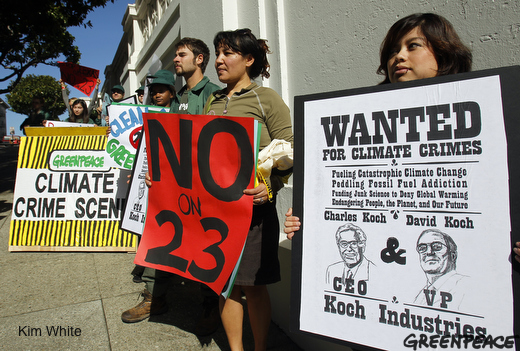 Photo: GreenpeaceThese Greenpeace activists are only a small part of the large clean energy coalition in California.
Photo: GreenpeaceThese Greenpeace activists are only a small part of the large clean energy coalition in California.
New polls happily show that the majority of Californians reject the deceptive, job-killing ballot measure Proposition 23. But what the polls do not show — and what few news outlets are covering — is the striking diversity of voices that are demanding clean energy.
Californians of all colors and classes are rejecting the false notion that protecting the planet and our public health will hurt the economy. Prop 23 — which is funded by Texas oil companies and would effectively repeal the state’s landmark clean energy and environmental protection laws — is running into a buzz-saw of opposition from a broad spectrum of Californians.
What’s happening in California is truly amazing. Hundreds of thousands of voices from literally every political, ethnic, faith, and socio-economic spectrum, are all working for the same cause. This beautiful coalition gives us a glimpse of the green path forward toward clean energy, a prosperous sustainable economy, and a healthier planet.
In my 2008 book, The Green Collar Economy, I outlined a vision for a “Green Growth Alliance.” This coalition, I argued, should include labor, social justice activists, environmentalists, students, and faith organizations — along with green business interests. I argued that such an alliance could “change the face of politics in this country.”
In California, thanks to the hard work of groups like Stop the Dirty Energy Proposition, the Energy Action Coalition, Latino Coalition for a Healthy California, and Communities United Against the Dirty Energy Prop, this alignment is coming into being.
Last week, the No on Prop 23 campaign picked up a surge of support from groups that included a council of inter-faith leaders, university academics, one of the wealthiest men in the world (Bill Gates), an award-winning Hollywood director (James Cameron), former Vice President Al Gore and even President Obama.
But supporters are not just the rich and famous. This coalition includes social justice organizations of all creeds and colors, whose missions are to empower the voices of the working class and communities of color — including immigrants. These groups understand that less smog means less asthma, fewer trips to the emergency room, and healthier neighborhoods for their children.
The coalition also includes a group of investors who represent more than $421 billion in assets, much of it in the clean tech sector. They make the case that clean energy technology is the next wave of the industrial revolution, and California is poised to become a leader in innovation, job creation, and commercialization of these technologies. However, they also warn that reversing course on policy — precisely what Prop 23 aims to achieve — will cause investment to flow elsewhere (mainly to places like China and parts of Europe), and doom California and the rest of the nation to be left behind during the biggest revolution of the new global economy.
These groups represent just the tip of iceberg in a movement that includes environmentalists, politicians from both parties, students, public health organizations, big and small businesses, labor groups, consumer groups, senior citizens, and public safety organizations.
A vision for the future of green growth
At the national and global levels, the green movement has suffered setbacks, most notably the failure of comprehensive climate and clean energy in Congress. The main culprit: the deep pockets of the dirty energy lobby, which spent more than $500 million to buy influence among (mostly Republican) lawmakers. The rise of tea parties, climate deniers, and conservative TV and radio pundits, also created barriers to the preservation of the planet, the protection of public health and promotion of new jobs.
But what we see happening in California gives the green movement a reason for continued optimism. This time we hold the high ground — protecting our bipartisan, pro-jobs, pro-innovation climate laws that are already on the books. The fight has unmasked the opponents of clean energy, as well as vetted their arguments — the same tired talking points they have been using to kill progress for the last four decades.
More importantly than unmasking our enemies, this fight has revealed our friends and allies. It turns out that, given the opportunity, huge swaths of Californian’s, from all walks of life, can find common value in supporting cleaner air and a commitment to growing the clean technology sector.
The fight is far from over, and with Election Day approaching in just a few days, the stakes are higher than ever. But victory in California can give us a model for the coalition that is needed to achieve a green growth victory in Washington D.C. and the rest of the nation.



